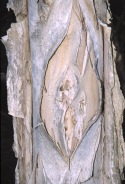 "A lot of these people were coast people too, see, and they'd go both ways.
They'd travel a certain time one way and then they'd travel back at a different
time of the year. Hunting, living off the land, gathering kangaroo skins, just
hunting and collecting skins. They'd do their trip and they'd come back with
a bundle of skins. They were telling me that when they were selling skins
back in those very early days they got a pound a pound. So that was good
money if you had enough skins.
"A lot of these people were coast people too, see, and they'd go both ways.
They'd travel a certain time one way and then they'd travel back at a different
time of the year. Hunting, living off the land, gathering kangaroo skins, just
hunting and collecting skins. They'd do their trip and they'd come back with
a bundle of skins. They were telling me that when they were selling skins
back in those very early days they got a pound a pound. So that was good
money if you had enough skins.
But they would travel right down along the coast there. Like I mentioned before all of these properties had permanent fresh water. That's why they built along there, because it was pretty arid country in those days and I guess the rivers would have been fresh in those very early settlement days too. But they went along the coast and would go so far-the different groups. The Pallinup River mob, the Beaufort Inlet mob there was a traditional campsite there and there were many families, who in the past, lived there all year round. And of course people had their own locations right along the coast and they would always visit each other from time to time. There was always that sort of interaction right through and I guess that's how everybody got married in the end I suppose.
They tell me that the Bremer Bay tribe was one of the biggest tribes around, the Gairdner River mob was the other very large tribe as well. All of these people at different times would have gone into Jerramungup Homestead once that became established. So you'd get one or two people working there and you'd have fifty or sixty just hanging on there having a free ride. They'd have to find them things to do just for a bit of flour, tea, sugar, a bit of dripping or something. The rations were very meagre in those days. So a lot of cheap labour went on in those days with clearing the land and things like that.
Noongars lived pretty well; they were healthy people back in those days. I've
seen photographs of these people from that era, big, huge men, healthy
looking people, well dressed too. But they used to survive out there; they
used to walk from Bremer Bay across to Doubtful Island because there was
a big camp as I mentioned before at Peppermint Beach, between Bremer
and Doubtful. Some of my family was born there, my great grandmother
was born in Bremer Bay. And her mother, my great, great grandmother
comes from Esperance, which again supports the fact that people did travel
long distances.

The rivers were a real source of survival for the Noongar people no matter
where you go right throughout the country, nationally you know. All the
waterways supported Noongars' survival in those days because of the game,
there was plenty of game, there was fish, everything was there. They would
take their pick of what sort of food they wanted, some would go digging the
tubers."
Aden Eades
"The amazing part of it was, and some of the old Noongars aren't quite sure,
but the majority of them that I've spoken to have told me that the old
grandmas were the ones that carried the fire sticks as they were travelling
from one area to another. They never lit any of the bush until they were told
by the grandpas, the old men, the elders, and as I said some evenings they
wouldn't light them before 6 o'clock."
Jeff Ellett



